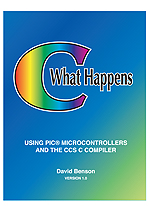
Book Title:C What Happens Using PIC® Microcontrollersand the CCS C Compiler by David Benson
Description:"C What Happens Using PIC® Microcontrollers and the CCS C Compiler," contains a series of explanations and examples for those who want to learn to program PIC® microcontrollers using the C programming language. It is assumed that the reader has no knowledge of PIC microcontrollers or programming, but does have a rudimentary understanding of electronics. The reader will learn to create programs by making selections from a large variety of built-in functions provided in the CCS C compiler, writing his/her own functions as needed, and writing executable statements. The reader will 'C what happens' by programming a PIC® microcontroller with the newly created code and exercising it using a simple circuit described in the book. The subject matter is laid out in a logical progression from simple to not-so-simple and is illustrated with lots of examples. The complete table of contents follows:
Table of Contents
INTRODUCTION
PIC MICROCONTROLLER PRODUCT OVERVIEW
SELECTING A DEVICE FOR EXPERIMENTS
PIC16F818
Pins and functions
Package
Clock oscillator
Reset
Ports
Special Features
PIC microcontroller architecture
Code and data protection
Configuration bits
CIRCUIT FOR PIC16F818 EXPERIMENTS
CHOOSING DEVELOPMENT TOOLS
CCS compiler
Device programming methods
Device programmers and ease of running code examples
Device programmer
In-circuit serial programmer
Choosing a device programmer
Microchip PICSTART Plus
Choosing an in-circuit programmer/debugger
CCS ICD-U40 (or -S40)
Microchip PICkit 2®
Microchip ICD 2®
PROGRAMMING A DEVICE USING THE ICD-U40 (or -S40)
PROGRAMMING A DEVICE USING THE PICkit 2®
PROGRAMMING A DEVICE USING THE ICD 2®
PROGRAMMING A DEVICE USING THE PICSTART Plus®
CCS COMPILER
C SOURCE CODE
What it looks like
Typing accuracy
Comments
Text And Formatting
BITS, BYTES, ETC.
Bit
Nibble
Byte
Binary
Hexadecimal
CONSTANTS
VARIABLES
DATA
Data types
ASCII characters
NAMING CONSTANTS AND VARIABLES
Reserved words in C
OPERATORS - SHORT LIST
TRUE vs. FALSE
DEVICE FILES
PRE-PROCESSOR DIRECTIVES - SHORT LIST
INs AND OUTS OF DIGITAL I/O
CONFIGURATION REGISTER(S) FUSES
FUNCTIONS
main() function
Functions
Built-in functions - short list
STATEMENTS
Executable statements
Blocks
Conditional statements
Semicolon use rules
PROGRAM DESIGN
Program design - control flow
if
if/else
while loop
do/while loop
for loop
switch/case
break
continue
return
goto
Rule
Modular programming
WRITING PROGRAMS (With Experiments)
Programming concepts
Programming examples
Simple data transfers
Loop - endless
While loop
Do/while loop
Port registers accessed as variables
- Port addresses defined using #byte directives
- Port addresses defined using user-created include file
- Port addresses defined using get environment built-in function
Loop with a counter
For loop
Loop until
While loop
Comparisons
Relational operators
If/else
Switch/case
Function calls and time delays
Bit-level I/O using built-in functions
Bit toggle
If statement - read switch position
! logical operator
&& logical operator (two switches)
|| logical operator (two switches)
if/else, else, else
Read input bit, write output bit
Event counting
Bit manipulation using bit manipulation functions
Bit set/clear
Bit testing
Flags
#bit pre-processor directive example
typedef example
Bit manipulation using bitwise operators
Shift bits right or left
Change specific bit to"1"
Change specific bit to"0"
Change specific bit to it's complement
Goto
Function library
Cut and paste
TALKING TO A PIC MICROCONTROLLER WITH A PC VIA A WINDOWS TERMINAL PROGRAM
"U"-turn experiment
PC-to-PC "2-lane highway" experiment
PC/PIC microcontroller
PC baud rates
RS-232 interface for a PIC microcontroller
PIC microcontroller-to-PC serial communication
Formatting PIC microcontroller data on a PC screen
STRINGS
ARRAYS
Index to an array
Step through array elements
Extract nth element from array
Add offset to index
Lookup tables
7-segment LED display
STRUCTURES
Structures and ports - bit fields
MATH AND MANIPULATING NUMBERS
Mathematical operators
Operator precedence
Data type selection considerations
Formatting variables such as math results for printing
PASSING VARIABLES
Passing arguments
Returning values
Prototyping functions
OPERATORS
Assignment operator
Relational operators
Logical operators
Increment and decrement
Mathematical operators
Bitwise operators
Pointer operators
Structure operators
Operators that don't fit the categories
INTERRUPTS
External interrupt sources
Internal interrupt sources
Timer 0 interrupt
Port B interrupt on change - bits 7,6,5,4
Interrupts generated by other peripherals
Global interrupt enable flag (GIE)
Return from interrupt
Where to put the interrupt service routine in program memory
Interrupt latency
Multiple external interrupt sources
Interrupts in C
Functions - Built-in
Pre-processor directives used to identify interrupt service routines
Example - external interrupt
TIMING AND COUNTING USING TIMER 0
Digital output waveforms
Using timer 0
Prescaler
Putting timer 0 to work
Setting up timer 0
Starting timer 0
Counter
How do we know timer 0 is doing something?
Timer 0 will keep on counting as long as:
Timer 0 must be reloaded after each overflow for repeating time intervals
Stopping timer 0
Timer 0 experiments
Digital output waveform using timer 0 - internal clock
Single time interval - internal clock
Free running mode - internal clock - 0.1 second period
Single time interval - external clock
Free running mode - internal clock
Counting events (pulses)
Going further
ANALOG TO DIGITAL CONVERSION
INSERTING ASSEMBLY CODE IN C CODE
APPENDIX A - PULSER
APPENDIX B - SOURCES
APPENDIX C - HEXADECIMAL NUMBERS
APPENDIX D - PROGRAM LISTINGS vs. PAGE NUMBERS
لینک دانلود (مستقیم)
http://pertican2007.dl.rapidbaz.com/V-qf/C_Wht_Hppns.pdf
میرور:
http://rapidshare.com/files/306989696/C_Wht_Hppns.pdf
کد HTML:
<abbr=کاربر عزیز لطفا مطلبتون رو فقط در یک مکان قرار بدید.شما در تاپیک درخواست کتاب جواب دادید.این تاپیک قفل میشه.با تشکر></abbr>

